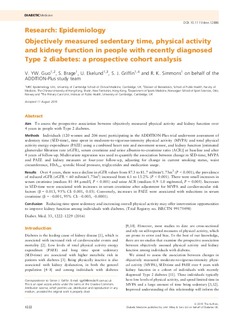Objectively measured sedentary time, physical activity and kidney function in people with recently diagnosed Type 2 diabetes: a prospective cohort analysis
Journal article, Peer reviewed
Permanent lenke
http://hdl.handle.net/11250/2433050Utgivelsesdato
2015-09-08Metadata
Vis full innførselSamlinger
- Artikler / Articles [2119]
Sammendrag
Aim: To assess the prospective association between objectively measured physical activity and kidney function over 4 years in people with Type 2 diabetes. Methods: Individuals (120 women and 206 men) participating in the ADDITION-Plus trial underwent assessment of sedentary time (SED-time), time spent in moderate-to-vigorous-intensity physical activity (MVPA) and total physical activity energy expenditure (PAEE) using a combined heart rate and movement sensor, and kidney function [estimated glomerular filtration rate (eGFR), serum creatinine and urine albumin-to-creatinine ratio (ACR)] at baseline and after 4 years of follow-up. Multivariate regression was used to quantify the association between change in SED-time, MVPA and PAEE and kidney measures at four-year follow-up, adjusting for change in current smoking status, waist circumference, HbA1c, systolic blood pressure, triglycerides and medication usage. Results: Over 4 years, there was a decline in eGFR values from 87.3 to 81.7 ml/min/1.73m2 (P < 0.001); the prevalence of reduced eGFR (eGFR < 60 ml/min/1.73m2) increased from 6.1 to 13.2% (P < 0.001). There were small increases in serum creatinine (median: 81–84 μmol/l, P < 0.001) and urine ACR (median: 0.9–1.0 mg/mmol, P = 0.005). Increases in SED-time were associated with increases in serum creatinine after adjustment for MVPA and cardiovascular risk factors (β = 0.013, 95% CI: 0.001, 0.03). Conversely, increases in PAEE were associated with reductions in serum creatinine (β = –0.001, 95% CI: –0.003, –0.0001). Conclusion: Reducing time spent sedentary and increasing overall physical activity may offer intervention opportunities to improve kidney function among individuals with diabetes.
Utgiver
WileyTidsskrift
Diabetic MedicineBeslektede innførsler
Viser innførsler beslektet ved tittel, forfatter og emneord.
-
Youth screen-time behaviour is associated with cardiovascular risk in young adulthood: The European Youth Heart Study
Grøntved, Anders; Ried-Larsen, Mathias; Møller, Niels C.; Kristensen, Peter Lund; Wedderkopp, Niels; Froberg, Karsten; Hu, Frank B.; Ekelund, Ulf; Andersen, Lars Bo (Journal article; Peer reviewed, 2012-07-05)Aims: We prospectively examined the association of TV viewing, computer use, and total screen time in adolescence, and change in these behaviours, with cardiovascular disease (CVD) risk factors in young adulthood. Methods ... -
Associations between objectively measured physical activity intensity in childhood and measures of subclinical cardiovascular disease in adolescence: prospective observations from the European Youth Heart Study
Ried-Larsen, Mathias; Grøntved, Anders; Møller, Niels Christian; Larsen, Kristian Traberg; Froberg, Karsten; Andersen, Lars Bo (Journal article; Peer reviewed, 2013-04-13)BACKGROUND AND AIM: No prospective studies have investigated the association between physical activity (PA) and carotid subclinical cardiovascular disease across childhood. Therefore, the primary aim was to investigate ... -
Recommended aerobic fitness level for metabolic health in children and adolescents: a study of diagnostic accuracy
Adegboye, Amanda R. A.; Anderssen, Sigmund A.; Froberg, Karsten; Sardinha, Luis B.; Heitmann, Berit L.; Steene-Johannessen, Jostein; Kolle, Elin; Andersen, Lars Bo (Journal article; Peer reviewed, 2010)Objective To define the optimal cut-off for low aerobic fitness and to evaluate its accuracy to predict clustering of risk factors for cardiovascular disease in children and adolescents. Design Study of diagnostic ...
